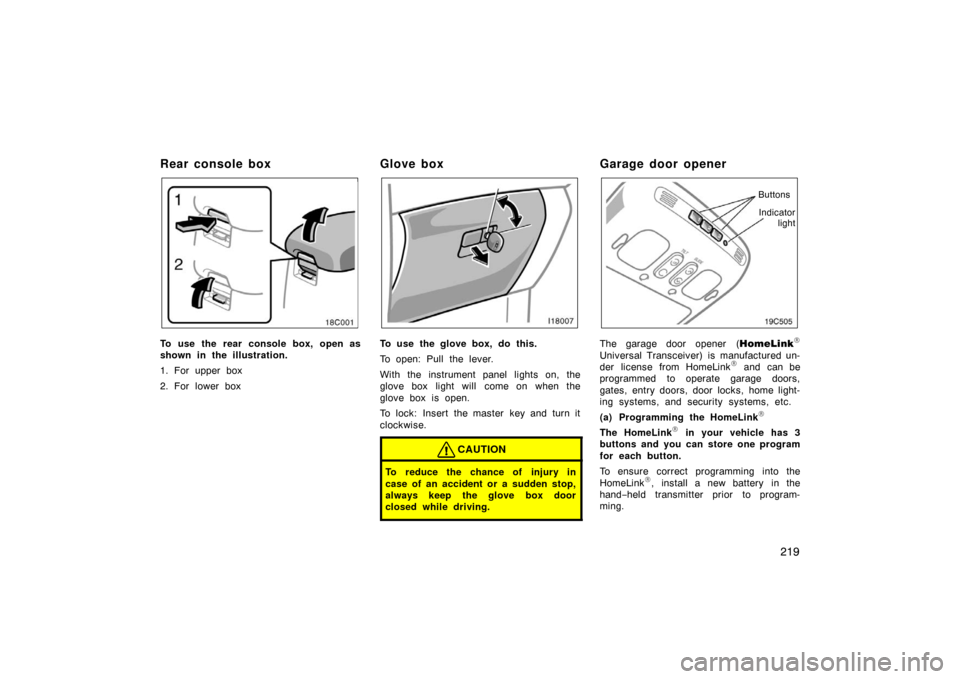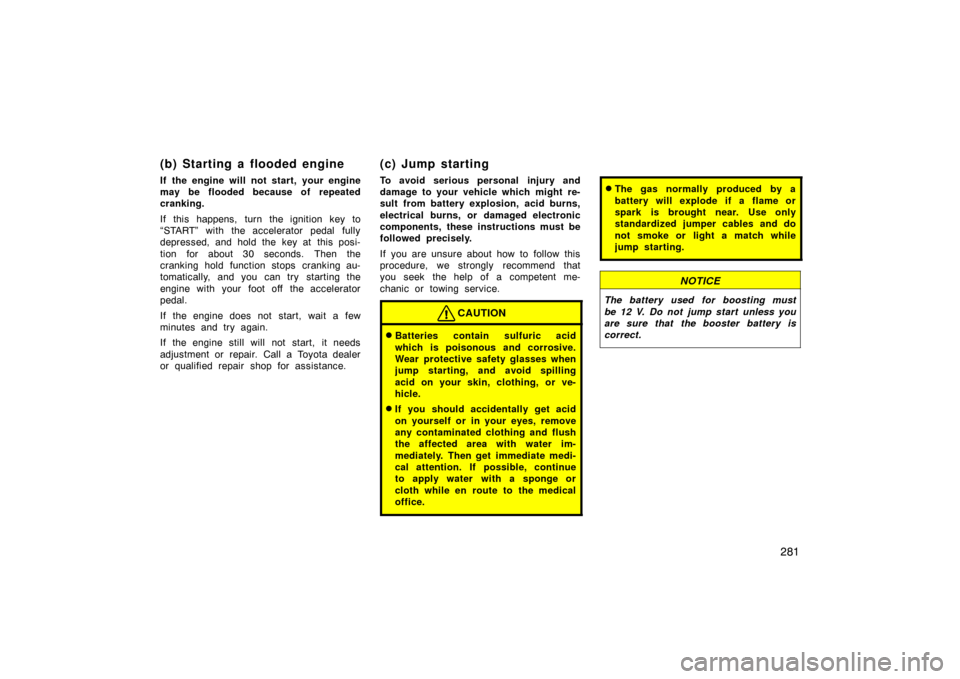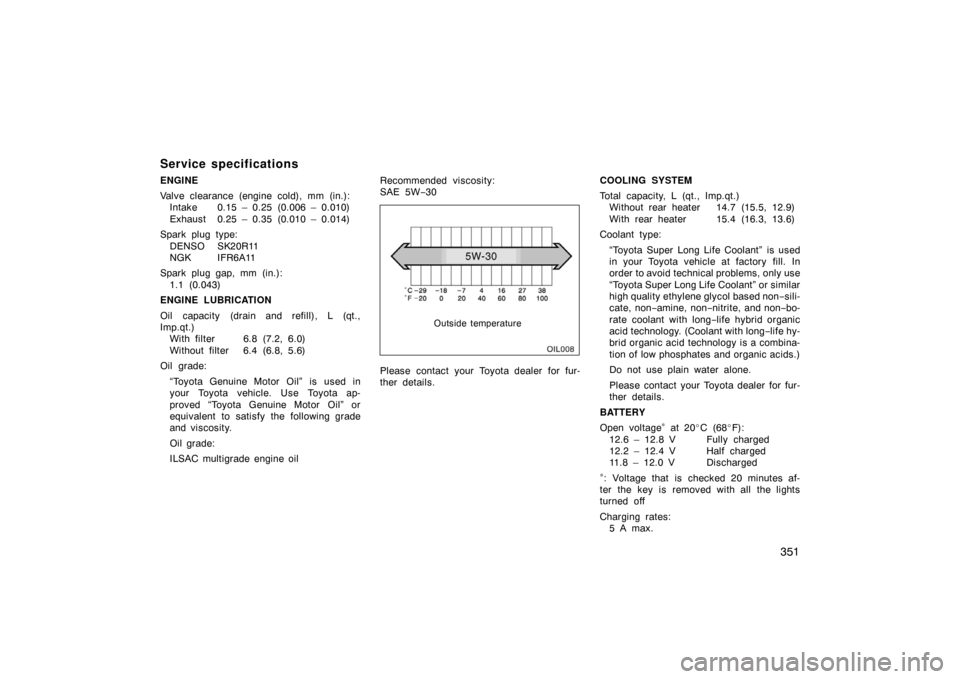Page 231 of 374
217
Power outlets
The power outlets are designed for
power supply for car accessories. To
use them, open the lids as shown in
the following illustrations.
The key must be in the “ACC” or “ON”
position to be used.
NOTICE
�To prevent the fuse from being
blown, do not use the electricity
over the total vehicle capacity of
12V/120W (all the outlets together).
� To prevent the battery from being
discharged, do not use the power
outlets longer than necessary when
the engine is not running.
� Close the power outlet lids when
the power outlets are not in use.
Inserting anything other than an ap-
propriate plug that fits the outlet,
or allowing any liquid to get into
the outlet may cause electrical fail-
ure or short circuits.
Instrument panel
Rear console box
(Vehicles without navigation system)
Rear console box
(Vehicles with navigation system)
Luggage compartment
Page 233 of 374

219
Rear console box
To use the rear console box, open as
shown in the illustration.
1. For upper box
2. For lower box
Glove box
To use the glove box, do this.
To open: Pull the lever.
With the instrument panel lights on, the
glove box light will come on when the
glove box is open.
To lock: Insert the master key and turn it
clockwise.
CAUTION
To reduce the chance of injury in
case of an accident or a sudden stop,
always keep the glove box door
closed while driving.
Garage door opener
Indicatorlight
Buttons
The garage door opener (
HomeLink
Universal Transceiver) is manufactured un-
der license from HomeLink and can be
programmed to operate garage doors,
gates, entry doors, door locks, home light-
ing systems, and security systems, etc.
(a) Programming the HomeLink
The HomeLink in your vehicle has 3
buttons and you can store one program
for each button.
To ensure correct programming into the
HomeLink
, install a new battery in the
hand− held transmitter prior to program-
ming.
Page 294 of 374

280
Before making these checks, make sure
you have followed the correct starting
procedure given in “How to start the
engine” on page 262 and that you have
sufficient fuel. Also check whether the
other keys will start the engine. If they
work, your key may be broken. Have the
key checked at your Toyota dealer. If
none of your keys work, there may be a
malfunction in the immobilizer system. Call
your Toyota dealer. (See “Keys” on page
10.)If the engine is not turning over or is
turning over too slowly—
1. Check that the battery terminals are tight and clean.
2. If the battery terminals are O.K., switch on the interior light.
3. If the light is out, dim or goes out when the starter is cranked, the battery
is discharged. You may try jump start-
ing. See “(c) Jump starting” for further
instructions.
If the light is O.K., but the engine still will
not start, it needs adjustment or repair.
Call a Toyota dealer or qualified repair
shop.
NOTICE
Do not pull� or push�start the ve-
hicle. It may damage the vehicle or
cause a collision when the engine
starts. Also the three�way catalytic
converter may overheat and become a
fire hazard.
If the engine turns over at its normal
speed but will not start— 1. The engine may be flooded because of repeated cranking. See “(b) Starting a
flooded engine” for further instructions.
2. If the engine still will not start, it needs adjustment or repair. Call a Toyota
dealer or qualified repair shop.
If your vehicle will not start—
(a) Simple checks
Page 295 of 374

281
(b) Starting a flooded engine
If the engine will not start, your engine
may be flooded because of repeated
cranking.
If this happens, turn the ignition key to
“START” with the accelerator pedal fully
depressed, and hold the key at this posi-
tion for about 30 seconds. Then the
cranking hold function stops cranking au-
tomatically, and you can try starting the
engine with your foot off the accelerator
pedal.
If the engine does not start, wait a few
minutes and try again.
If the engine still will not start, it needs
adjustment or repair. Call a Toyota dealer
or qualified repair shop for assistance.
(c) Jump starting
To avoid serious personal injury and
damage to your vehicle which might re-
sult from battery explosion, acid burns,
electrical burns, or damaged electronic
components, these instructions must be
followed precisely.
If you are unsure about how to follow this
procedure, we strongly recommend that
you seek the help of a competent me-
chanic or towing service.
CAUTION
�Batteries contain sulfuric acid
which is poisonous and corrosive.
Wear protective safety glasses when
jump starting, and avoid spilling
acid on your skin, clothing, or ve-
hicle.
�If you should accidentally get acid
on yourself or in your eyes, remove
any contaminated clothing and flush
the affected area with water im-
mediately. Then get immediate medi-
cal attention. If possible, continue
to apply water with a sponge or
cloth while en route to the medical
office.
�The gas normally produced by a
battery will explode if a flame or
spark is brought near. Use only
standardized jumper cables and do
not smoke or light a match while
jump starting.
NOTICE
The battery used for boosting must
be 12 V. Do not jump start unless you
are sure that the booster battery is
correct.
Page 365 of 374

351
Service specifications
ENGINE
Valve clearance (engine cold), mm (in.):Intake 0.15 – 0.25 (0.006 – 0.010)
Exhaust 0.25 – 0.35 (0.010 – 0.014)
Spark plug type: DENSO SK20R11
NGK IFR6A11
Spark plug gap, mm (in.): 1.1 (0.043)
ENGINE LUBRICATION
Oil capacity (drain and refill), L (qt.,
Imp.qt.) With filter 6.8 (7.2, 6.0)
Without filter 6.4 (6.8, 5.6)
Oil grade:
“Toyota Genuine Motor Oil” is used in
your Toyota vehicle. Use Toyota ap-
proved “Toyota Genuine Motor Oil” or
equivalent to satisfy the following grade
and viscosity.
Oil grade:
ILSAC multigrade engine oil Recommended viscosity:
SAE 5W
−30
Outside temperature
Please contact your Toyota dealer for fur-
ther details. COOLING SYSTEM
Total capacity, L (qt., Imp.qt.)
Without rear heater 14.7 (15.5, 12.9)
With rear heater 15.4 (16.3, 13.6)
Coolant type:
“Toyota Super Long Life Coolant” is used
in your Toyota vehicle at factory fill. In
order to avoid technical problems, only use
“Toyota Super Long Life Coolant” or similar
high quality ethylene glycol based non −sili-
cate, non −amine, non− nitrite, and non− bo-
rate coolant with long −life hybrid organic
acid technology. (Coolant with long −life hy-
brid organic acid technology is a combina-
tion of low phosphates and organic acids.)
Do not use plain water alone.
Please contact your Toyota dealer for fur-
ther details.
BATTERY
Open voltage
∗ at 20 �C (68 �F):
12.6 – 12.8 V Fully charged
12.2 – 12.4 V Half charged
11.8 – 12.0 V Discharged
∗: Voltage that is checked 20 minutes af-
ter the key is removed with all the lights
turned off
Charging rates: 5 A max.